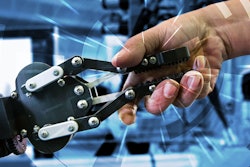MAXIMIZING THE EFFECTIVENESS OF IIOT
USING CENTRALIZED MANUFACTURING MANAGEMENT
SOFTWARE TO GATHER AND ANALYZE I IOT DATA
+1 714 996 5302
www.parsec-corp.com
180 N Riverview Drive No. 300
Anaheim, CA 92808, United States
TM
Maximiz ing the Ef fec t i veness of I IoT2
INTRODUCTION
Imagine a scenario in which every stage of the production
cycle has the capability to communicate with one another —
from engineering to suppliers, through the production floor
and out the door to the end user. The MES/MOM applications
are running at their maximum efficiency to optimize inventory
and production demands. A fully connected factory soon
begins to realize quality, competitive, productivity and
profitability benefits that could not have been realized
without its installation.
Bringing together factories, supply chain members, quality
control, data management and customer service under one
communication umbrella affords the opportunity to spot
problems earlier, implement cost savings at all levels, improve
customer satisfaction and increase profitability. In short, the
ability to connect efficiently affects the ability to compete
effectively.
“The Industrial Internet is indeed transformative. It will change the basis of competition, redraw
industry boundaries and create a new wave of disruptive companies, just as the current Internet has
given rise to Amazon, Google and Netflix.”1 -World Economic Forum, 2015
Maximiz ing the Ef fec t i veness of I IoT 3
THE THREE STAGES OF
CONNECTED FACTORIES
In the future, IIoT will bring together people, machines and data into a seamless continuum that
will enable manufacturers to improve their productivity, efficiency, quality control, customer
satisfaction and profitability.
With an IIoT framework in place, it is hoped that the smart
machines that are communicating with each other will be
better than their human counterparts at capturing, analyzing
and communicating data.
Problems and concerns should be identifiable and fixable
much earlier in the production cycle, leading to higher levels
of customer satisfaction. But many factories have yet to fully
implement an IIoT-based system. Instead they find themselves
in one of the following three stages:
Pre-Software
A significant percentage of the industrial community still has
no software solution in place to connect departments. All
aspects of the factory are in silos, operating autonomously
from one another. For example, the quality control
department may not talk to suppliers early in the production
cycle to try to identify and improve quality issues. This leads
to an inefficient flow of information, which could affect the
quality of the product delivered to the end user.
Semi-Connected Factory
Some operations have realized the need for increased
connectivity, but they have not yet taken a complete leap
into its installation on a system-wide basis. They might be
relying on some type of homegrown solution or point solution
that connects pieces of the factory, but not all of it, into one
unified system. This would be similar to having a digital device
that can help increase one element of efficiency, but it is not
yet connected to the web to gather information from multiple
sources. For example, the company may have implemented
a system for quality control to talk to suppliers to work out
issues regarding product specifications, but elsewhere in
the organization, Operations is not alerting Maintenance to
the cause of a persistent downtime issue, which is causing a
severe disruption in production. While certainly better than
the pre-software stage, this still leaves the factory in a state
of lowered connectivity, which affects its ability to operate at
the highest rates of efficiency.
Connected Factory
This is a factory or operation that has a fully functioning MES/
MOM (Manufacturing Execution Systems/Manufacturing
Operations Management) in place. These capabilities enable
the entity to utilize IIoT to its fullest potential by completely
streamlining the value stream and optimizing all processes.
IIoT serves the functions of analyzing data, implementing
systems and taking action without the need for human
intervention at every step of the way. This provides the
company with the ability to identify lapses in the supply chain
that could lead to production delays, spotlight shipments
received that are not up to engineering specifications, and
could lower product quality or identify product defects that
could endanger the company’s quality reputation.
POSSIBLE BARRIERS TO
CONNECTIVITY
Insufficient Vision and Direction
Without a well-crafted plan in place, an IIoT implementation
is doomed to failure. A vision must first be supplied from
top management, then various stakeholders must come
together to agree on the path that needs to be taken.
Individual departments will need to break out of their silos so
as to mutually gather, share, analyze and act on data for the
corporate good.
Disparate Systems Among Various Entities
While the global economy is rapidly expanding, it also leads to
a lack of uniformity among participants — some are at more
advanced levels than others. It may be easier to mandate
IIoT internally, but it can be difficult to convince suppliers,
outsiders or newer members of the system to join in the
IIoT system. All members of the production loop need to be
brought under one seamless system that takes advantage of
the latest in software and hardware to achieve its goals.
Lack of Security Controls
The unfortunate downside to an increase in connectivity is
an accompanying increase in the potential for disruption. The
news media has highlighted a recent increase in the number of
hacking episodes, which could have significant repercussions
in the industrial world’s application of IIoT paradigms.
Planning must allow for the incorporation of advanced cyber
threat protection solutions into the network.
IIoT is a relative newcomer to the industrial world. While early adopters will benefit most with
streamlined competitive advantages, several considerations need to be analyzed and resolved
on the path to full integration.
Need for Powerful Software Platforms
Hardware is only as effective as the software behind it.
Software provides the ability to turn raw data, numbers and
statistics from various sources into information that can be
used to make crucial decisions. The best solutions allow for
enhanced communication and response mechanisms across
the manufacturing life cycle in real-time.
With enormous amounts of unsorted data flying around the
factory, IIoT-ready manufacturers will need to find a software
solution to address this growing problem. After all, power
without control is wasted.
When thinking forward to a software solution, to match the
vast data of IIoT, it must include the following features and
functions to properly connect a factory: production planning,
scheduling, performance management, workflow and labor
management, work-in-progress, inventory management,
sustainability and energy management, and material
management to name a few.
With a unified and integrated software solution managing
data, assets, and processes, operators and managers can
look to proven continuous improvement methods to further
increase the bottom-line.
Maximiz ing the Ef fec t i veness of I IoT4
Maximiz ing the Ef fec t i veness of I IoT 5
GET READY FOR THE IIOT
REVOLUTION
Those in manufacturing who fail to adapt now will miss out on a crucial competitive advantage
that is becoming rapidly available. Actions need to be taken at each step of the process, with
the ultimate goal of connectivity in mind. Manufacturers can look at current equipment,
equipment purchases, supplier contracts and customer service communications with an eye
toward unification and openness.
In an age of global competition, manufacturers that insist on continuing to follow old tactics
and procedures will find themselves losing out to their more connected and agile global
competitors. Companies need to take a hard look at where they stand now in the connected
world and change their mind-set so that they will be able to take full advantage of all that IIoT
has to offer. It can be a bold new step into the future, but it will certainly be one that provides
incredible advantages to those willing to take the initial steps out of their comfort zone.
Factories of the present need to identify at which point they are in the
connectivity cycle and make plans now to get on board with IIoT before
it really takes off and they get left behind.
References
1 The World Economic Forum in conjunction with Accenture. Industrial Internet of Things:
Unleashing the Potential of Connected Products and Services, January 2015. http://www3.
weforum.org/docs/WEFUSA_IndustrialInternet_Report2015.pdf.
About Parsec
Parsec is the developer of TrakSYS™, a proven operations management software application
and solution platform designed to significantly improve manufacturing processes. Parsec is
committed to providing best-in-class products and solutions to our worldwide community of
clients to assist them in optimizing their manufacturing operations. There are thousands of
TrakSYS™ licenses in use around the globe in a wide variety of Industries.
TrakSYS™ helps manufacturers to maximize asset utilization and efficiency, increase capacity
with no new capital equipment, reduce production costs, decrease lead time, and improve
profitability. For more information about Parsec and TrakSYS™ please visit the corporate
website at www.parsec-corp.com.
MAXIMIZING THE EFFECTIVENESS OF IIOT
In the future, IIoT will bring together people, machines and data into a seamless continuum that will enable manufacturers to improve their productivity, efficiency, quality control, customer satisfaction and profitability. Download this white paper to see how you can maximize the effectiveness of IIoT in your factory.
Latest in Home
Regional Manufacturing: The Future of a Resilient Industry
September 16, 2025
NHTSA Investigating Tesla Door Handles That Could Trap Passengers
September 16, 2025
Ford to Cut Up to 1,000 Jobs at German Plant as EV Demand Lags
September 16, 2025






















